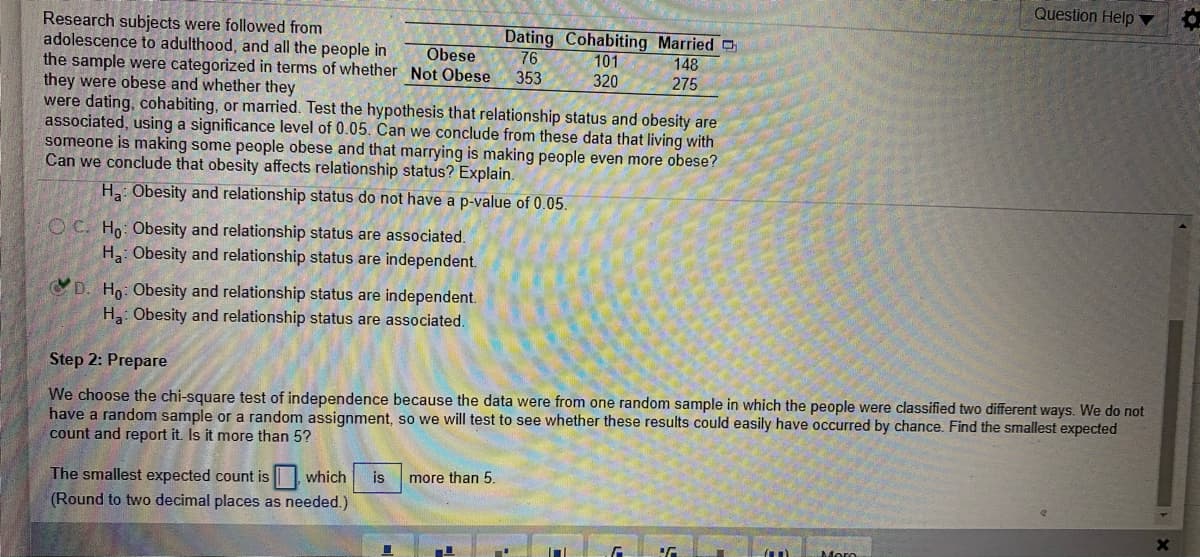Question Help Research subjects were followed from adolescence to adulthood, and all the people in the sample were categorized in terms of whether Not Obese they were obese and whether they were dating, cohabiting, or married. Test the hypothesis that relationship status and obesity are associated, using a significance level of 0.05. Can we conclude from these data that living with someone is making some people obese and that marrying is making people even more obese? Can we conclude that obesity affects relationship status? Explain. Dating Cohabiting Married 76 Obese 101 148 353 320 275 H Obesity and relationship status do not have a p-value of 0.05. O C. Ho: Obesity and relationship status are associated. Ha: Obesity and relationship status are independent. D. Ho: Obesity and relationship status are independent. H: Obesity and relationship status are associated. Step 2: Prepare We choose the chi-square test of independence because the data were from one random sample in which the people were classified two different ways. We do not have a random sample or a random assignment, so we will test to see whether these results could easily have occurred by chance. Find the smallest expected count and report it. Is it more than 5? The smallest expected count is which (Round to two decimal places as needed.) is more than 5
Question Help Research subjects were followed from adolescence to adulthood, and all the people in the sample were categorized in terms of whether Not Obese they were obese and whether they were dating, cohabiting, or married. Test the hypothesis that relationship status and obesity are associated, using a significance level of 0.05. Can we conclude from these data that living with someone is making some people obese and that marrying is making people even more obese? Can we conclude that obesity affects relationship status? Explain. Dating Cohabiting Married 76 Obese 101 148 353 320 275 H Obesity and relationship status do not have a p-value of 0.05. O C. Ho: Obesity and relationship status are associated. Ha: Obesity and relationship status are independent. D. Ho: Obesity and relationship status are independent. H: Obesity and relationship status are associated. Step 2: Prepare We choose the chi-square test of independence because the data were from one random sample in which the people were classified two different ways. We do not have a random sample or a random assignment, so we will test to see whether these results could easily have occurred by chance. Find the smallest expected count and report it. Is it more than 5? The smallest expected count is which (Round to two decimal places as needed.) is more than 5
Glencoe Algebra 1, Student Edition, 9780079039897, 0079039898, 2018
18th Edition
ISBN:9780079039897
Author:Carter
Publisher:Carter
Chapter10: Statistics
Section: Chapter Questions
Problem 13PT
Related questions
Concept explainers
Contingency Table
A contingency table can be defined as the visual representation of the relationship between two or more categorical variables that can be evaluated and registered. It is a categorical version of the scatterplot, which is used to investigate the linear relationship between two variables. A contingency table is indeed a type of frequency distribution table that displays two variables at the same time.
Binomial Distribution
Binomial is an algebraic expression of the sum or the difference of two terms. Before knowing about binomial distribution, we must know about the binomial theorem.
Topic Video
Question
How do you find the expected amount?

Transcribed Image Text:Question Help
Research subjects were followed from
adolescence to adulthood, and all the people in
the sample were categorized in terms of whether Not Obese
they were obese and whether they
were dating, cohabiting, or married. Test the hypothesis that relationship status and obesity are
associated, using a significance level of 0.05. Can we conclude from these data that living with
someone is making some people obese and that marrying is making people even more obese?
Can we conclude that obesity affects relationship status? Explain.
Dating Cohabiting Married
76
Obese
101
148
353
320
275
H Obesity and relationship status do not have a p-value of 0.05.
O C. Ho: Obesity and relationship status are associated.
Ha: Obesity and relationship status are independent.
D. Ho: Obesity and relationship status are independent.
H: Obesity and relationship status are associated.
Step 2: Prepare
We choose the chi-square test of independence because the data were from one random sample in which the people were classified two different ways. We do not
have a random sample or a random assignment, so we will test to see whether these results could easily have occurred by chance. Find the smallest expected
count and report it. Is it more than 5?
The smallest expected count is which
(Round to two decimal places as needed.)
is
more than 5.
Moro
Expert Solution
This question has been solved!
Explore an expertly crafted, step-by-step solution for a thorough understanding of key concepts.
This is a popular solution!
Trending now
This is a popular solution!
Step by step
Solved in 2 steps

Knowledge Booster
Learn more about
Need a deep-dive on the concept behind this application? Look no further. Learn more about this topic, statistics and related others by exploring similar questions and additional content below.Recommended textbooks for you

Glencoe Algebra 1, Student Edition, 9780079039897…
Algebra
ISBN:
9780079039897
Author:
Carter
Publisher:
McGraw Hill

Big Ideas Math A Bridge To Success Algebra 1: Stu…
Algebra
ISBN:
9781680331141
Author:
HOUGHTON MIFFLIN HARCOURT
Publisher:
Houghton Mifflin Harcourt


Glencoe Algebra 1, Student Edition, 9780079039897…
Algebra
ISBN:
9780079039897
Author:
Carter
Publisher:
McGraw Hill

Big Ideas Math A Bridge To Success Algebra 1: Stu…
Algebra
ISBN:
9781680331141
Author:
HOUGHTON MIFFLIN HARCOURT
Publisher:
Houghton Mifflin Harcourt


College Algebra (MindTap Course List)
Algebra
ISBN:
9781305652231
Author:
R. David Gustafson, Jeff Hughes
Publisher:
Cengage Learning